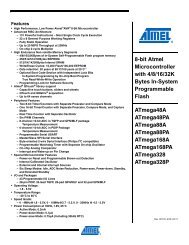ARDX-experimenters-g.. - Oomlout
ARDX-experimenters-g.. - Oomlout
ARDX-experimenters-g.. - Oomlout
You also want an ePaper? Increase the reach of your titles
YUMPU automatically turns print PDFs into web optimized ePapers that Google loves.
04 ELEC<br />
electronics<br />
primer<br />
.: A Small Electronics Primer:.<br />
Electronics in Brief<br />
No previous electronic experience is required to have fun with this kit. Here are a few details<br />
about each component to make identifying, and perhaps understanding them, a bit easier. If at<br />
any point you are worried about how a component is used or why its not working the internet<br />
offers a treasure trove of advice, or we can be contacted at help@oomlout.com<br />
Component Details<br />
LED<br />
(Light Emitting Diode)<br />
What it Does:<br />
No. of Leads:<br />
Emits light when a small current is passed 2 (one longer this one connects to positive)<br />
through it. (only in one direction)<br />
Things to watch out for:<br />
Identifying: - Will only work in one direction<br />
Looks like a mini light bulb. - Requires a current limiting resistor<br />
More Details on Wikipedia:<br />
http://tinyurl.com/zhpyv<br />
Diode What it Does: No. of Leads:<br />
The electronic equivalent of a one way 2<br />
valve. Allowing current to flow in one Things to watch out for:<br />
direction but not the other. - Will only work in one direction (current will<br />
Identifying:<br />
flow if end with the line is connected to ground)<br />
Usually a cylinder with wires extending from More Details on Wikipedia:<br />
either end. (and an off center line indicating polarity)<br />
http://tinyurl.com/ysz57b<br />
Resistors<br />
What it Does: No. of Leads:<br />
Restricts the amount of current that can flow 2<br />
through a circuit.<br />
Things to watch out for:<br />
Identifying: - Easy to grab the wrong value (double check<br />
Cylinder with wires extending from either<br />
the colors before using)<br />
end. The resistance value is displayed using More Details on Wikipedia:<br />
a color coding system (for details see next http://tinyurl.com/cmeqw5<br />
page)<br />
Transistor What it Does: No. of Leads:<br />
Uses a small current to switch or amplify a 3 (Base, Collector, Emitter)<br />
much larger current.<br />
Things to watch out for:<br />
Identifying: - Plugging in the right way round.(also a<br />
Comes in many different packages but you<br />
current limiting resistor is often needed on the base pin)<br />
can read the part number off the package. More Details on Wikipedia:<br />
(P2N2222AG in this kit and find a datasheet online) http://tinyurl.com/eazkn<br />
Hobby Servo<br />
What it Does:<br />
No. of Leads:<br />
Takes a timed pulse and converts it into an 3<br />
angular position of the output shaft.<br />
Things to watch out for:<br />
Identifying: - The plug is not polarized so make sure it<br />
A plastic box with 3 wires coming out one is plugged in the right way.<br />
side and a shaft with a plastic horn out the More Details:<br />
top. http://tinyurl.com/4zo4he<br />
DC Motor What it Does: No. of Leads:<br />
06<br />
Spins when a current is passed through it. 2<br />
Identifying:<br />
Things to watch out for:<br />
This one is easy, it looks like a motor. Usually - Using a transistor or relay that is rated for<br />
a cylinder with a shaft coming out of one the size of motor you're using.<br />
end<br />
More Details on Wikipedia:<br />
http://tinyurl.com/d826yh
















